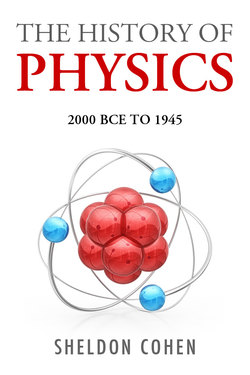Читать книгу The History of Physics from 2000BCE to 1945 - Sheldon J.D. Cohen - Страница 6
На сайте Литреса книга снята с продажи.
ATOMS ELEMENTS COMPOUNDS
ОглавлениеBoyle’s work also laid the foundation for ending the concept of air, fire, earth, and water as the basic four elements. Boyle said speculation as to the basic elements served no purpose and an element was anything that could not be broken down further by chemical manipulation. Chemists then started on the trail of elements and eventually it was determined that gases, such as oxygen and nitrogen were elements, and iron, copper, gold, silver, and the mercury used in Boyle’s experiments were elements.
This led to the definition of a compound (latin meaning put together), which was any substance put together by a combination of elements.
Joseph Louis Proust (1754-1826) was born in France and trained as a pharmacist. He taught and did research in Spain for twenty years. Napoleon’s invasion of Spain forced him back to France where he did his most important work.
Chemists of the time were trying to determine the proportion of elements within each compound. The French chemist Claude Berthollet (1748-1822) stated that the compounds could vary in composition depending upon the amount and proportion of the reactants used in the formation of the compounds.
Proust experimented with copper carbonate and separated it into copper, carbon, and oxygen in a ratio of five to one to four. No matter how he did the experiment this was the result. If he added more of one of the elements in a greater proportion then there ordinarily would be in the compound, he founded some of the element left over. He found the same thing to be true for other compounds he worked with. They always had a fixed amount of elements in a definite proportion. He named this the law of definite proportions, and other chemists confirmed his work. Berthollet eventually had to admit that his concept was wrong and Proust’s was right.
Proust’s work supported the concept of the indivisibility of atoms.
John Dalton (1766-1844) was an English chemist who worked with gases and discovered that different gases could have different proportions of the same elements. For instance: the substance carbon monoxide had one part carbon and one part oxygen, while the compound carbon dioxide had one part carbon and two parts oxygen. (mon is a Greek word for one and di is a Greek word for two). He called this the law of multiple proportions, although each compound followed the law of definite proportions. He agreed that all chemical elements were composed of atoms, and each atom of an element had the same mass, whereas different elements had different atomic masses, and it was these masses that differentiated one element from another. Dalton also said that atoms combine with each other in whole number ratios. As example 1:1, 1:2, 1:3, 2:4, etc. Since atoms were indivisible, it was impossible for a fraction of an atom to combine to form a compound.
William Nicholson (1753-1815) was an English chemist who determined that the composition of a water molecule was two parts hydrogen and one part oxygen (molecule is from the Latin meaning small mass). When he passed an electric current through water, oxygen and hydrogen bubbled out. The mass of the oxygen was eight times the mass of the two hydrogen atoms. Since there were two hydrogen atoms in every water molecule, it meant that a single oxygen atom had sixteen times more mass then a single hydrogen atom. Dalton had actually referred to this as weight, but weight refers to the gravitational pull of a body by the earth and mass refers to the amount of matter contained in the individual atoms. Mass is the preferable term, but Dalton’s calling it weight has stuck and to this day we refer to atomic weights.
Jons Jacob Berzelius (1799-1848) was a Swedish chemist who worked out atomic weights for hydrogen and many other elements. He confirmed that every element had a different atomic weight.
Dmitri Ivanovich Mendeleev (1834-1907) was a Russian chemist who developed a table of elements with increasing atomic weights. He demonstrated that some properties of the elements repeat themselves in an orderly fashion, and these elements fall into the same column. This method of arrangement caused gaps in the columns that Mendeleev felt represented undiscovered elements. Time would prove him right.
